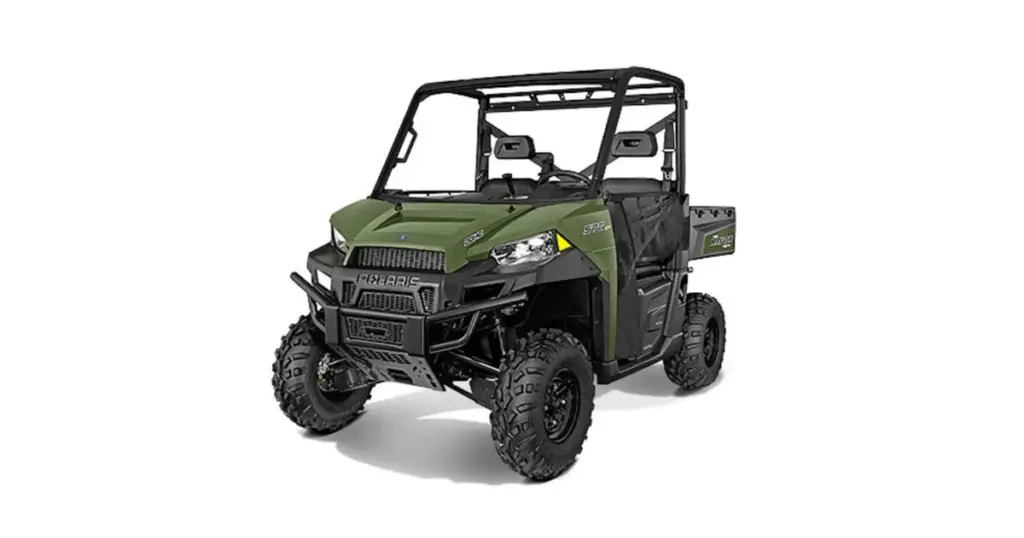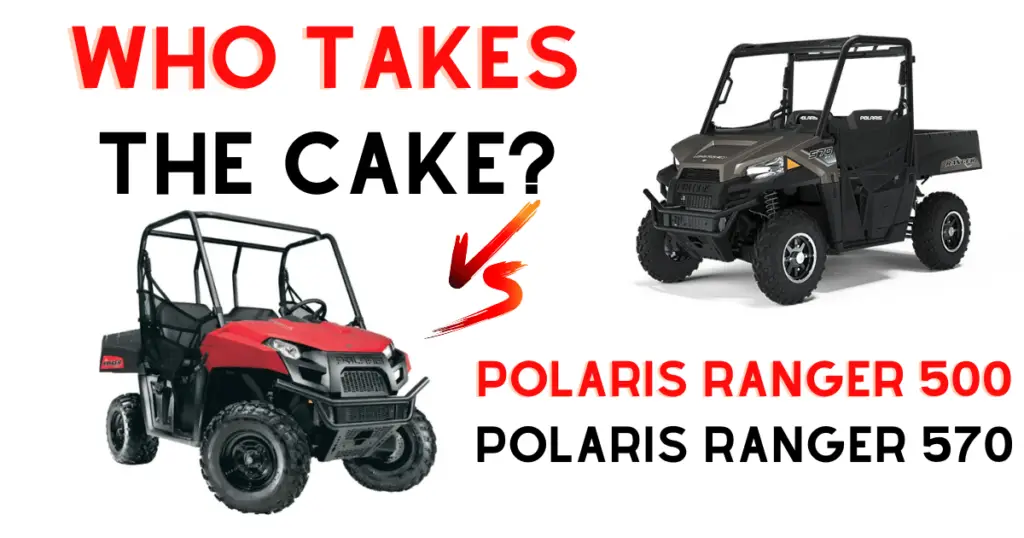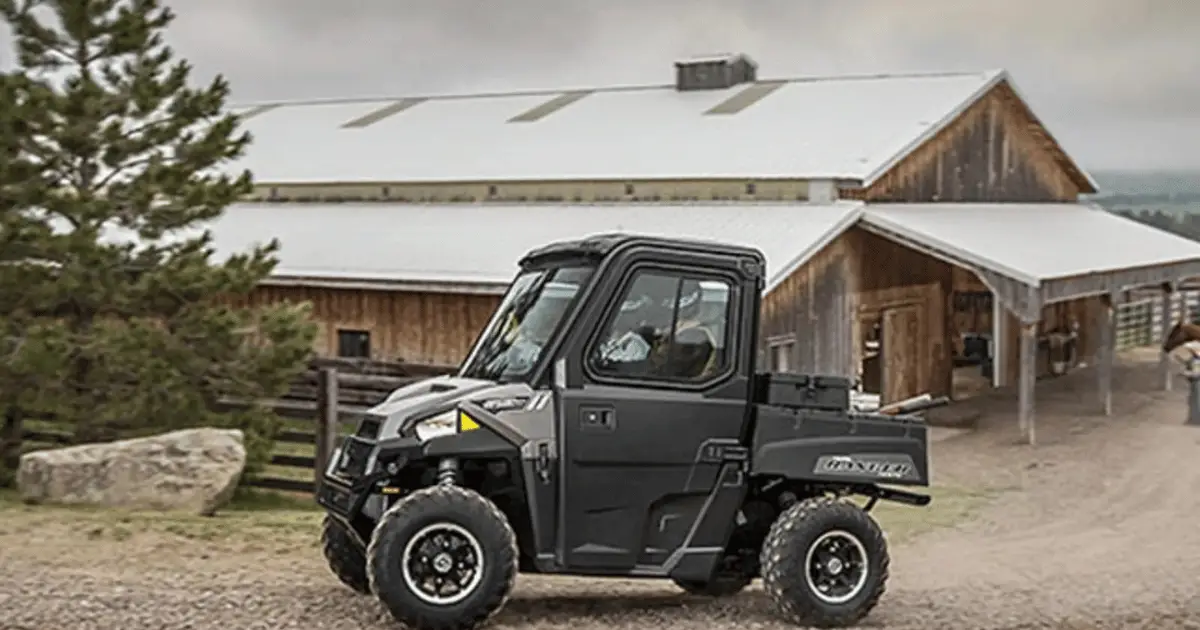When it comes to utility terrain vehicles (UTVs), the names Polaris Ranger 500 and 570 are quite familiar. Both models are renowned for their robustness and performance. However, if you’re torn between the Ranger 500 vs 570, this comprehensive Polars Ranger 500 vs 570 showdown will help you make an informed decision. Ready? let’s get to it!
Main Features of Polaris Ranger 500

The Polaris Ranger 500 is a mid-size UTV known for its powerful performance and practical features. Let’s delve deeper into its characteristics.
Engine and Performance
The Ranger 500 is equipped with a ProStar 500 engine, a four-stroke powerhouse that generates 500cc of power. The liquid-cooled technology prevents the risk of overheating, ensuring continuous performance even under heavy-duty tasks.
Physical Dimensions
The Ranger 500 measures 110 inches in length and 58 inches in width, which could necessitate an upgrade if you’re switching from a regular ATV. The UTV weighs about 1,065 pounds (dry weight).
Towing and Hauling Capacity
The Ranger 500 leads its class when it comes to towing and hauling. With a towing capacity of 1,500 pounds, it can easily haul hunting gear, smaller farm equipment, or another ATV. The bed box measures 42 inches in width, providing ample space for equipment and gear.
Fuel Efficiency
The Ranger 500 comes with a 9-gallon fuel tank, estimated to provide between 15 to 20 miles of travel per gallon, reducing the need for frequent refills during long excursions.
However, as we move forward it’s important to remember that any mechanical object is prone to experiencing issues: The Definitive Polaris Ranger 500 Troubleshooting Guide
And a specific issue to be aware of: Polaris Ranger 500 Fuel Pump Problems (Guide to Fix)
Polaris Ranger 570 Performance Comparison

Let’s now turn our attention to the Polaris Ranger 570 and see how it compares with its 500 counterpart.
Engine and Performance
The Polaris Ranger 570 outperforms the 500 model when it comes to engine power. It features an onboard 500cc ProStar engine integrated with 32 horsepower, offering superior performance.
Physical Dimensions
The Ranger 570 is spacious enough to comfortably accommodate two adults. The bed box measures 32″ L X 42″ W X 11-1/2″ H, which is ideal for transporting small to medium-sized equipment and tools.
Towing and Hauling Capacity
Like the Ranger 500, the 570 model also boasts a 1,500-pound towing capacity. Its 1,000-pound payload capacity can accommodate a driver, a passenger, and gear.
Fuel Efficiency
The Ranger 570, similar to the 500, features a 9-gallon fuel tank, reducing the frequency of refills and facilitating longer excursions.
Just like the 500, the Ranger 570 is prone to its own set of issues: Polaris Ranger 570 Problems: A Complete Guide (and Fixes)

Unique Selling Points of Each Model
Polaris Ranger 500
The Ranger 500’s unique selling point lies in its robust ProStar 500 engine, which delivers impressive power and performance. Its excellent towing and hauling capacity make it a versatile choice for various tasks. Moreover, the automatic transmission offers ease of operation, especially for beginners.
Polaris Ranger 570
The Ranger 570 stands out with its larger, more powerful engine. This model is also more spacious, with enough room to comfortably accommodate two adults. The 570 also offers a superior braking system that utilizes hydraulics to minimize the driver’s effort.
Price Differences Between Ranger 500 and 570
There are noticeable differences in the pricing of the Ranger 500 and 570. The Ranger 500 is typically costlier by about $1,000. However, this price difference can vary depending on the specific features, accessories, and packages you choose.
Pros and Cons of Polaris Ranger 500
The Ranger 500 has several advantages. Its robust engine delivers reliable performance, and it offers an impressive towing and hauling capacity. The model’s automatic transmission also allows for easy operation.
However, there are a few drawbacks. The Ranger 500 is only available in an automatic transmission, which may not appeal to those who prefer manual shifting. Also, its larger width could limit maneuverability in tight spaces.
Pros and Cons of Polaris Ranger 570
The Ranger 570’s larger engine and added horsepower are definite pros, providing more power for heavy-duty tasks. Also, its hydraulic braking system ensures effective braking with minimal effort from the driver.
On the downside, the 570 model is larger, which could pose challenges when navigating narrow trails or tight spaces. Moreover, its higher price point might be a deterrent for some buyers.
However, it’s important to ask a serious question: What are the Polaris Ranger years to avoid?
Which Model Offers Better Value for Money?
When considering the Ranger 500 vs 570, both models offer great value for money, providing robust performance, impressive towing capacity, and practical features. The choice often comes down to individual requirements and budget constraints.
While the Ranger 500 is an excellent choice for individuals looking for a powerful, versatile UTV with an automatic transmission, the Ranger 570 is suitable for those who need more power and space and don’t mind paying a bit extra.
Fuel Efficiency: Ranger 500 vs 570
Both the Ranger 500 and 570 models feature a 9-gallon fuel tank, offering similar fuel efficiency. They are estimated to provide between 15 to 20 miles per gallon, making them economical choices for long excursions.
User Reviews Comparison

Both the Ranger 500 and 570 garner positive reviews from users, with praises for their robust performance, hauling and towing capacities, and fuel efficiency. However, some users found the Ranger 570’s larger engine and additional horsepower more appealing, providing better performance for heavy-duty tasks.
Common Issues Reported for Each Model
As with any vehicle, the Ranger 500 and 570 are not immune to issues. Common problems reported by users include overheating in extreme conditions and minor issues with the automatic transmission in the Ranger 500. Meanwhile, some Ranger 570 users have reported challenges navigating in tight spaces due to the model’s larger size.
Off-road Capabilities Comparison
In terms of off-road capabilities, both the Ranger 500 and 570 offer impressive performance. Their high ground clearance and powerful engines allow them to easily navigate rough terrains, making them ideal choices for off-road adventures.
Suitability for Heavy-duty Tasks
While both models are capable of handling heavy-duty tasks, the Ranger 570’s larger engine and additional horsepower make it more suitable for such tasks. Its spacious interior and larger bed box also provide more space for hauling equipment and gear.
Beginner-friendliness: Ranger 500 vs 570
The Ranger 500, with its automatic transmission and robust but manageable power, is an excellent choice for beginners. On the other hand, the Ranger 570, despite its larger engine, is also relatively easy to operate, making both models beginner-friendly.
Maintenance and Longevity Comparison
Both the Ranger 500 and 570 are renowned for their durability and longevity. Regular maintenance, including timely oil changes and tire checks, can further extend their lifespan. However, due to its larger engine, the Ranger 570 might require slightly more frequent maintenance.
Updates and Improvements in the Newer 570 Model
The newer models of the Ranger 570 come with several upgrades and improvements, including a more powerful engine, improved suspension, and enhanced user comfort features. These enhancements further boost its performance and value for money.
Size and Weight Differences
The Ranger 570 is larger than the 500, offering more space for passengers and hauling gear. However, this larger size can make it slightly more challenging to maneuver in tight spaces. In terms of weight, both models are quite similar, with the Ranger 500 weighing in at about 1,065 pounds (dry weight).
In conclusion, both the Polaris Ranger 500 and 570 offer robust performance, impressive towing and hauling capacities, and excellent off-road capabilities. The choice between the Ranger 500 vs 570 largely depends on your specific needs and budget. By considering the aspects discussed above, you can make an informed decision and select the model that suits your requirements best.
With all of this in mind, I’ll ask you the next question I think you should consider: How many miles will a Polaris Ranger last?
Frequently Asked Questions
Are Polaris Ranger 500 Any Good?
The Polaris Ranger 500 is generally well-regarded for its versatility and reliability. It’s designed for both work and recreation, offering a balanced blend of performance and efficiency. Its smaller size compared to larger models makes it more maneuverable in tight spaces.
How Fast Will a 570 Polaris Ranger Go?
The 570 Polaris Ranger can reach a top speed of approximately 50 miles per hour. This speed can vary slightly based on the terrain, the weight of the cargo and passengers, and other factors.
How Much Horsepower Does a Ranger 500 Have?
The Ranger 500 is equipped with a 32 horsepower engine. This power output is suitable for various tasks, including light to moderate towing and off-road navigation.
Does the Ranger 500 Have Power Steering?
The Polaris Ranger 500 does not come standard with power steering. However, some models and trims might offer this feature as an additional option or upgrade.
How Much HP Does a Ranger 570 Have?
The Polaris Ranger 570 features a more powerful engine than the 500, with 44 horsepower. This extra power provides enhanced performance, especially in more demanding tasks or challenging terrain.
Is the Polaris Ranger 570 Any Good?
The Polaris Ranger 570 is highly rated for its performance and durability. It strikes a balance between power and efficiency, making it suitable for a variety of uses. It’s especially popular for those needing a reliable utility vehicle that can handle both work-related tasks and recreational activities.

Leave a Reply